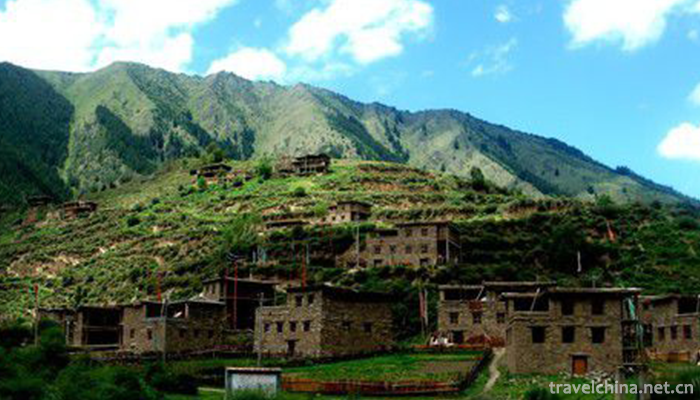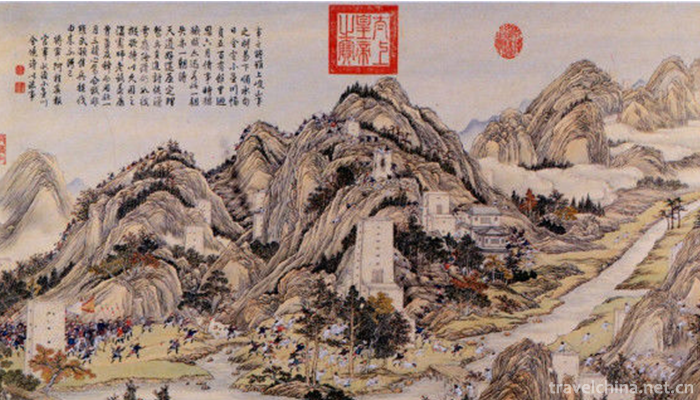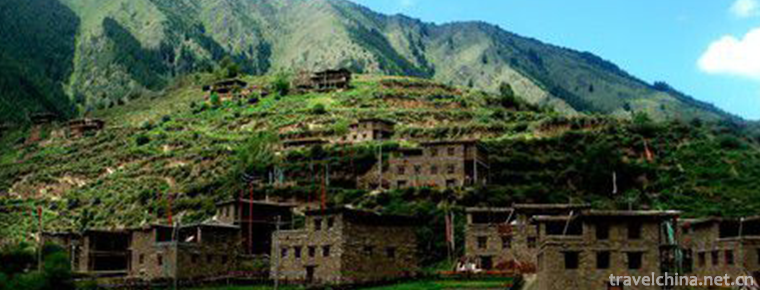Construction Techniques of Tibetan Diaolou
Construction Techniques of Tibetan Diaolou
Gabu Tibetan ancient building complex is located on the second terrace on the north-east Bank of Mako River, 3 kilometers northeast of Lighthouse Township, Banma County, Guoluo Tibetan Autonomous Prefecture, Qinghai Province. This kind of Tibetan architecture is more common in the Marco River Basin, and its distribution is scattered, but it is concentrated in the village of Gabzhu. These dwellings have a history of about 300 years. Due to the long-term war and the fighting among tribes, a large number of Tibetan dwellings have been built in Banma, especially in the Marco River Basin.
On June 7, 2008, Tibetan blockhouse construction techniques were approved by the State Council and listed in the second batch of national intangible cultural heritage list.
geographical position
Gabu Tibetan ancient building complex is located on the second terrace on the North Bank of Mako River, 3 kilometers northeast of Lighthouse Township, Banma County, Guoluo Tibetan Autonomous Prefecture, Qinghai Province. There are 21 Tibetan-style ancient buildings, covering an area of 18,000 square meters. This kind of Tibetan architecture is more common in the Marco River Basin, and its distribution is scattered, but it is concentrated in the village of Gabzhu. These dwellings have a history of about 300 years. Due to the long-term war and the fighting among tribes, a large number of Tibetan dwellings have been built in Banma, especially in the Marco River Basin.
Architectural features
These Tibetan residential buildings are quite distinctive. They are generally built on high platforms or on top of hills. The building materials are mainly stone, supplemented by wood, and stone walls are easy to defend and difficult to attack, so as to ensure safety. The whole building is about 10 meters high, with flat roofs, interlaced walls of stone and wood, and interstitial loess masonry. The first floor of the barn is four beams and eight columns. Each floor is connected by a single wooden ladder, which is made of the whole log. On the one hand, it is easy to cut down and smooth, while cutting out a ladder slot. On the other hand, this ladder can move freely, on the other hand, it can prevent uninvited visitors. The second floor is mainly composed of living rooms, halls, kitchens and corridors. The rooms are separated by cross-wood walls, with windows and flues on the outer walls. The flue entrance is generally triangular, 20 cm high and 10 cm wide, and is reserved on the back wall. The window is built on the side wall. Its shape is large, small and rectangular. The outer edge of the window is 30 centimeters high and 20 centimeters wide. The inner edge is 40 centimeters high and 30 centimeters wide. Its use has two aspects: lighting and defense. The outer edge of the house is separated by a wicker fence wall. The corridor is 1 metre wide and there is a toilet at the corner. The third floor is the Jingtang and the warehouse, and the outer wall has a lookout. Walls, doors and windows, ceiling and single wooden ladder are all of their own characteristics, and they are not painted.
Inheritance value
It was built by special Tibetan masons. Because the complex is rare, it has high artistic and research value in studying the living habits of ancient Tibetan groups and Tibetan architectural techniques.
Entering Tibetan
Crossing snow mountains, stepping grasslands, Gorges and torrents, in the hinterland of the Qinghai-Tibet Plateau, located in Banma County, Guoluo Tibetan Autonomous Prefecture, Qinghai Province, at an altitude of more than 3500 meters, there is a "secret land" covered by primitive forests. Here lies the Banma Tibetan Blockhouse Group, one of the most well-preserved Tibetan Blockhouse Communities in China.
One afternoon in June, reporters came to Banqian village, the most concentrated Tibetan blockhouse. As soon as we entered the village, we saw many towers facing the valley, standing in the sun, mossy walls and mottled wooden doors.
Guo Haimin, deputy director of Banma County Cultural and Sports Broadcasting and Television Bureau, told reporters that the Tibetan blockhouse in Banma is divided into three types: stone blockhouse, wooden blockhouse and mixed blockhouse, among which stone blockhouse is the most distinctive. The exterior wall is made of stone flakes. According to the structure similar to mortise and tenon, the size of the wall is interlocking and cross-vertical, so that the wall is uniform in force and not easy to crack and tilt.
Bunker history
According to Zhang Junqi, an expert of the Qinghai Institute of Cultural Relics and Archaeology, the Tibetan Diaolou in Banma, known as "Kuaige", can be traced back at least 800 years ago, mainly distributed in the villages of Banqian, Kopei and Gerize in Lighthouse Township. Among them, there are nearly 100 Diaolou in Banqian Village, most of which have a history of more than 300 years.
Climbing up to the roof, I saw a bright future. The river flows slowly through the valleys. The pebbles on the bottom of the river are clearly visible. From time to time, fish jump out of the water. On the other side of the river, at the foot of the mountains are farmland, and the top of the mountain is covered by patches of virgin forest. Under the sunshine, the fog rises in the forest, and even the shadow of the cloud can be seen moving slowly on the ground. In the fields and dense forests, many towers are built according to the mountains, just like the legendary vault in the sky.
According to Guo Haimin, before the 20th century, Banma was once one of the important trade routes in southwestern China, the ancient tea-horse road. The commercial road from Sailaitang to Tibet, the seat of its county government, was historically known as the "Saixi ancient road". While bringing wealth to Banma, businessmen and businessmen also brought the architectural styles of Sichuan, Gansu, Tibet, Tibet, Han and Yi nationalities to Banma, which made Banma Diaolou not only learn from the people's strengths, but also have its own characteristics.
Bunker preservation
Zhibo Diaolou, located in Zhibo Village, Songgang Township, Malkang County, Sichuan Province, was built during the reign of Qianlong in the Qing Dynasty. It is 43 meters high and has tilted 2.3 meters. It has survived three major earthquakes and is known as the "Leaning Tower of Pisa" in China. In July 2001, Zhibo Diaolou was recognized by the State Council as the fifth batch of key cultural relics protection units in China.
Zhibo Diaolou, Tibetan meaning "Guanzhai at the mouth of the canyon", is divided into two parts, north and south, built according to the mountain situation, South Diaolou in the village, North Diaolou in the North Ridge of the village. The two towers are about 50 meters apart.
Straight wave towers are 43 meters high, octagonal outside and circular inside. They are built with stone. The two pillars have distinct edges and corners, and the walls are smooth and cut. Octagonal Blockhouse has been used for more than 300 years, mainly for communication and defense in wartime.
Zhibo Diaolou has experienced the Dixi earthquake in 1933, the Songpan earthquake in 1976, and the Wenchuan earthquake in 2008. It has tilted 2.3 meters. It is called the "Leaning Tower of Pisa" in China.
Straight wave towers are perfect in shape, coordinated with the surrounding environment, integrated with the builder's aesthetic concept and exquisite skills, with high historical, ethnological and architectural technology and scientific value. It has been designated as a cultural relic protection unit at the county, state and provincial levels. July 2001.
Architectural complex
Distribution
Diaolou is mainly distributed in the Minjiang River, Dadu River, the upper reaches of Yalong River basin Qiang, Tibetan and other minority residential areas. As early as more than two thousand years ago, in The Biography of Southwest Yi in the Book of the Later Han Dynasty, it was recorded as follows: "Ranyi people,..." Everyone lives on the hill, and the fortress is the room. The taller is more than ten feet tall, which is the Qiongcage. "Qiongcage" is the transliteration of Qiang language "Qiaolou". Ran Qiang, the founder of Qiang cage, was a member of the ancient Qiang people. During the Qin and Han Dynasties, he lived mainly in the upper reaches of the Minjiang River. By the Sui and Tang Dynasties, blockhouse buildings were widespread in Western Sichuan and Eastern Tibet. "Sui Shu Fu Guo Zhuan" contains: Fu Guo "near the valley, near the mountain dangerous, vulgar revenge, the old base stone for the stone nest to avoid its trouble. Its stone nest is as high as more than ten feet, down to fifty-six feet, each level of more than ten feet, separated by wood. Its three or four steps, two or three steps above the stone nest, like a float map, open the door at the lower level, from the inside to the top, the night must be closed to guard against burglars. Gu Yanwu of the Ming Dynasty also had similar records in the Book of Diseases of the National Benefits of the Prefectures of the World: "Weiwei, Mao, Ancient Ranyidi, the barrier stones for living, such as the number of floating maps heavy, the door up and down with silk trees, goods hiding on top, living among them, stored in a circle, as high as 23 Zhangs of the chicken cage, more than 10 Zhang of the so-called blockhouse."
Effect
Regardless of the initial form of residence of a nation, the purpose of its ancestors'construction activities is always to resist the invasion of nature and other nationalities, hoping to obtain a stable, able to protect their homes, and seek a space for survival and rest. The Qiang and Tibetan ancestors living in the upper reaches of Minjiang, Dadu and Yalong rivers are no exception. Because of the frequent enemy fighting among and within ethnic groups for a long time, besides the need to build most villages in the mountains or high mountains easy to defend and difficult to attack, they also need to build strong and tall towers near their houses to defend against enemies and store grain and grass. This creates a precondition for the emergence of blockhouses.



-
2.Huizhou cake
Huizhou cake, originally named "jujube mud crisp baked bread", is a traditional feature in Huizhou area, Anhui Province.
Time 2018-11-27 -
3.Chaoyang Bird Fossil National Geological Park
Chaoyang Bird Fossil World Geopark is located in Chaoyang City, western Liaoning Province. Chaoyang is located at the junction of Liaoning, Hebei and Mongolia provinces in the throat of Chinese cock t
Time 2019-01-05 -
4.Devil City
The Devil City is also known as the Wind City of Urho. Wuerhe Mining Area in the lower reaches of Jiamu River, located in the northwest margin of Junggar Basin
Time 2019-02-07 -
5.Shenyang Science Centrum
Shenyang Science Palace is located in Wulihe Central Business District, Shenyang District, Liaoning Province. It is a large-scale modern popular science education base in Shenyang District. It was bui
Time 2019-02-08 -
6.Zhoucun Ancient Mall
Zhoucun Ancient Mall, also known as Street, is located in Zhoucun District, Zibo City, Shandong Province. The main road of Shandong Province, Jiqing Expressway
Time 2019-03-20 -
7.Eight treasures Orange Cup
Babao Orange Cup is a delicacy. Its main ingredients are mushrooms, horseshoe, ham and chicken breast.
Time 2019-03-25 -
8.Babu Zhai soup
Babaozhai soup is a traditional dish of Guangdong Province, which belongs to Cantonese cuisine. The soup tastes elegant and light, fresh and tasty, nutritious and has strong nourishing function.
Time 2019-03-27 -
9.Hengshui painting
Hengshui Inner Painting, a traditional folk art in Hengshui, Hebei Province, is one of the national intangible cultural heritage.
Time 2019-05-03 -
10.Mongolian Wedding
Mongolian young men and women marry on auspicious days, and men give gifts to women's homes. The gifts include cash, clothes, cloth, jewelry, rice and so on. There are cabinets, bedding, clothes, jewe
Time 2019-06-03 -
11.Qingming Festival
Qingming Festival, also known as Taqing Festival, Xingqing Festival, March Festival, ancestor worship festival, the festival period in mid-spring and late spring. Qingming Festival originated from anc
Time 2019-06-11 -
12.Shaoxing Ci Tone
Shaoxing Ci Diao, also known as Flower Diao, is commonly known as vernacular. It is a traditional folk song sung by blind artists (most of whom are women), and a story sung by three to nine people in
Time 2019-06-14